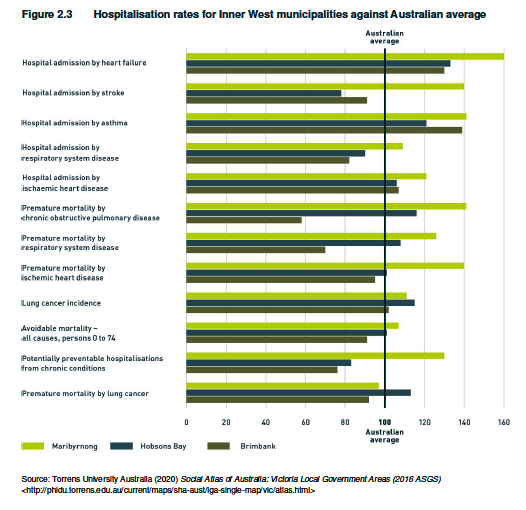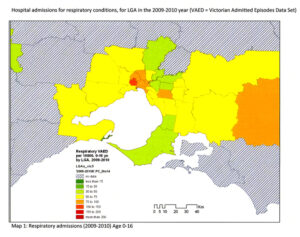Diesel Pollution
Did you know that Maribyrnong has Victoria’s highest rate of paediatric hospital admissions for respiratory illness? Or Victoria’s highest rate of hospital admissions for stroke? Something is very wrong.
Trucks are making us sick. We have been seeing health effects in our community from excess truck traffic for decades and the health issues we are facing have now become a crisis. In May 2023 the Maribyrnong City Council voted unanimously to declare an official health emergency in the City of Maribyrnong.
There are countless studies linking trucks, diesel emissions and public health issues, including increased hospital admissions, respiratory and cardiovascular illnesses and mortality. In 2023 the University of Melbourne’s Melbourne Climate Futures released an expert position statement finding that traffic pollution may be causing more than 11,000 deaths in Australia every year, a figure five times higher than previously estimated and 10 times the number who die in road crashes.
In May 2014, Environmental Justice Australia released ‘Clearing the Air’, a major report into Australia’s air pollution laws. This report identified Yarraville as one of Australia’s pollution hot spots “with some of the highest diesel pollution levels ever recorded in Australia”.
In 2017, the Social Health Atlas of Australia was released, a comprehensive report looking at health data around Australia. It showed that Yarraville, Seddon and Kingsville had higher rates of death by lung cancer than surrounding suburbs as well as much higher rates of death by cancers.
In 2020, the Inner West Air Quality Community Reference Group, which MTAG was represented on, released their major report – Air Pollution in Melbourne’s Inner West, taking direct action to reduce our community’s exposure.
This report, using the Social Health Atlas data, uncovered more alarming health statistics for the inner west, particularly the City of Maribyrnong, illustrated in the below graph. The results showed that the City of Maribyrnong, in particular, has rates of hospitalisation substantially higher than national averages for many diseases strongly linked to air pollution. Importantly, these rates cannot be explained by factors such as socio-economic status, smoking rates or age profiles, which are all close to the Australian average. For example, Maribyrnong has the worst cardiorespiratory outcomes across all metrics, even though it has the youngest demographic (only 10% of residents are over 65) and the lowest smoking and adult obesity rates in the inner west. This suggests that air pollution could be an important contributory factor.

In 2023 a series of incredibly comprehensive news articles focussed on the poor health of inner west residents and the devastating effects of air pollution. These articles are summarised on our page Air Pollution Crisis in the News.
An opinion piece also ran in The Age titled Dirty old trucks and sick kids. Melbourne, we’ve got a problem in the west written by Marion Terrill, director of the transport and cities program at the Grattan Institute.
The World Health Organisation classified diesel exhaust as a class one carcinogen back in 2012. This put diesel exhaust into the same category as other known hazards, such as cigarettes and asbestos. There is no safe level of exposure to diesel exhaust.
Children are particularly vulnerable to the effects of diesel pollution for a number of reasons. They spend more time outdoors than adults and are also more active. They breathe more quickly and breathe proportionately more air than adults – around 50% more per unit of body weight, increasing the amount of particulate matter they breathe. Their lungs and immune system are still developing and exposure early in life means damaged cells have less ability to repair and more time to become cancerous.
Governments have a duty of care to protect the health of citizens against known and preventable health impacts, such as excessive diesel pollution. To protect the health of residents in Melbourne’s inner west, the Government needs to get trucks off residential streets, clean up the trucking fleet and do all they can to protect the health of our impacted community.
Why is diesel pollution so dangerous?
Diesel exhaust is made up of both particulate matter as well as gasses such as nitrogen oxides and sulphur oxides. There are two ways diesel particulate damages our health – the size of the particles and their chemical composition.
Size: Particulate matter ranges in size from PM10 (at or below 10 micrometres in diameter) to ultrafine particles PM2.5 (at or below 2.5 micrometres) and down to PM1.0 (1 micrometre and smaller). The smaller the particulate matter, the further it penetrates into our bodies. PM10 are what make up the black soot we regularly find on the outside of our houses. Whilst too much of it can overwhelm our lungs and cause damage, our lungs are able to cough it up. It is the ultrafine particles, PM2.5 and PM1.0 that are of greatest concern. Our lungs cannot expel them. They penetrate the walls of our lungs, make their way into the bloodstream and travel around our bodies, even getting into the brain. Once they have lodged themselves into our bodies, they start causing damage and we have limited ability to flush them out.
Composition: Diesel particulate matter acts as a chemical hitchhiker. Chemical toxins attach themselves to the particulates, causing them to be delivered deep within our lungs and bloodstream. These toxins are made up of a dangerous cocktail of at least 450 different compounds including arsenic, benzene dioxins, formaldehyde and the two most carcinogenic chemicals ever discovered, 3-nitrobenzanthrone and 1,8-dinitropyrene.
Health Impacts of Diesel Pollution
Short term symptoms:
- Dizziness
- Light-headedness
- Nausea
- Coughing, wheezing and phlegm
- Difficult or laboured breathing
- Tightness of chest
- Irritation of the eyes, nose, throat and lungs
Long term symptoms:
- Cardiovascular disease
- Cardiopulmonary disease
- Lung cancer
- Inflammation of the lungs and airways
- Triggering of respiratory conditions such as asthma, bronchitis
- Respiratory diseases such as chronic obstructive pulmonary disease
- Lowered resistance to respiratory infection
- Mutations in chromosomes and damage to DNA
- Low birth weight/preterm babies
- Decrease in lung development and lung function in children
- Premature mortality

EPA air quality monitoring
During 2013 the EPA conducted a year long air quality monitoring program on Francis Street. Air pollution was measured at higher levels than any of the EPA’s other fixed air monitoring stations in residential suburbs of Melbourne. PM2.5 tracked at 8.2µg/m3 which is above Australia’s annual advisory standard of 8µg/m3. This is particularly concerning when health experts, including the Australian Medical Association claim that our air quality standards do not protect human health. In 2121 the World Health Organisation updated their air quality guidelines with a new PM2.5 standard of 5 µg/m3, well below the measurement on Francis St.
In 2020 MTAG worked with Queensland University of Technology’s International Laboratory for Air Quality & Health to install an air monitor on the corner of Francis St and Williamstown Road, outside the site of a planned child care centre. The data was analysed by the EPA, finding that air pollution levels breached the state’s standard on 39 days and had an annual PM2.5 rate double Australia’s standard and a staggering three times the WHO standard.
Watch a video of Associate Professor Louis Irving of the Department of Respiratory and Sleep Medicine at Melbourne University talking about the health effects of exposure to traffic pollution here.



